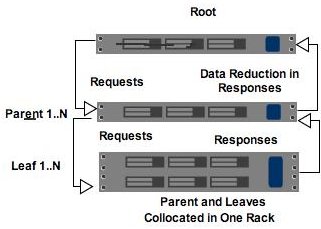The email sent will contain a link to this article, the article title, and an article excerpt (if available). For security reasons, your IP address will also be included in the sent email.

If a large number of leaf node machines send requests to a central root node then that root node can become overwhelmed:
- The CPU becomes a bottleneck, for either processing requests or sending replies, because it can't possibly deal with the flood of requests.
- The network interface becomes a bottleneck because a wide fan-in causes TCP drops and retransmissions, which causes latency. Then clients start retrying requests which quickly causes a spiral of death in an undisciplined system.
One solution to this problem is a strategy given by Dr. Jeff Dean, Head of Google's School of Infrastructure Wizardry, in this Stanford video presentation: Tree Distribution of Requests and Responses.

Instead of having a root node connected to leaves in a flat topology, the idea is to create a tree of nodes. So a root node talks to a number of parent nodes and the parent nodes talk to a number of leaf nodes. Requests are pushed down the tree through the parents and only hit a subset of the leaf nodes.
With this solution:














 Return to Article
Return to Article